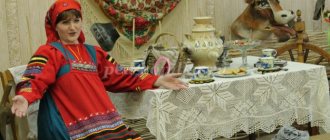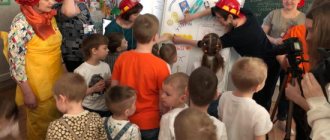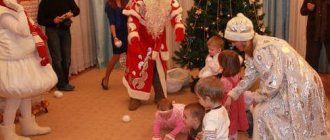"FOX AND HARES"
The “fox” child stands aside. The rest of the children - the “bunnies” - perform movements along the lines of the words. Bunnies ran across the forest lawn, What bunnies, runaway bunnies!
(run, jump)
The bunnies sat in a circle, the bunnies were digging a root, These are the bunnies, the bunnies - they run around! (sit down and “dig” with a pen)
Here is a little fox running, a red little fox, looking for where the bunnies are, the little bunnies, the little runners!
(the children freeze, the fox comes out and looks for
"bunny" who moved).
"BALLOON"
Children form a circle and hold hands. Following the teacher, children repeat movements and actions in accordance with the test.
My mother and I went to the store and bought a balloon there (they walk in a circle)
We will inflate the balloon, we will play with the balloon. (go back, expanding the circle)
Balloon, inflate, balloon, inflate (clap your hands)
Puff up big, but don't burst!
(hold hands and move back a little)
Oh, it burst!
(they let go of their hands and sit down).
“What games do modern preschoolers play?”
Preschool age is the stage of mental development from 3 to 6–7 years.
It is characterized by the fact that the leading activity is play. The game has
extremely important for the formation of a child’s personality.
The nature of the game changes along with the child’s development, and it also passes
stages.
Up to three years of age, the game involves manipulating objects.
The baby plays all the time he has free from sleeping and eating. With the help of toys he
gets acquainted with color, shape, sound, etc., that is, explores
reality. Later he begins to experiment on his own: quitting,
squeeze toys and observe the reaction. Child during play
develops coordination of movements. Actually, the game begins at 3 years old,
when a child begins to think in holistic images - symbols
real objects, phenomena and actions. At the first stage she presents
is a copying of the actions and behavior of adults. Toys at this time
are models of objects that adults “play” with. This is true
called a story game. The child reproduces stories during the process
actions. Role-playing game is an activity in which children take on
themselves certain functions of adults and in specially created by them
game, imaginary conditions are reproduced (or simulated)
activities of adults and relationships between them. That is, in the role-playing
The game satisfies the need to be like an adult. Role-playing game
- the most complex type of activity that a child masters at
throughout preschool age. The main characteristic of the game is the presence
imaginary situation.
In the game, all mental qualities and
personality traits of the child.
Gaming activity influences the formation of arbitrariness
behavior and all mental processes - from elementary to the most
complex. Performing a play role, the child subordinates all his
momentary, impulsive actions. Children focus better and
remember more in the conditions of the game than according to the direct instructions of an adult. Conscious goal - to concentrate, remember something, hold back
impulsive movement is the earliest and easiest to notice by a child in play.
Play has a strong influence on the mental development of a preschooler.
Acting with substitute objects, the child begins to operate in
conceivable, conventional space. The substitute object becomes a support
for thinking. Gradually, play activities are reduced, and the child
begins to act on the internal, mental plane. Thus,
the game helps the child switch to thinking in terms of images
and performances. In addition, in the game, performing various roles, the child
takes on different points of view and begins to see the subject from different
sides This promotes the development of essential thinking skills
person, allowing you to present a different view and a different point of view.
In middle preschool age - role-playing play, it predominates
up to 6-7 years. The most important thing for a child is role identification,
the plot fades into the background. The point of the game is to separate roles.
In the game he has the opportunity to live what is for him
inaccessible in the lives of adults.
Role play is critical to developing imagination.
Game actions take place in an imaginary, imaginary situation; real
objects are used as others, imaginary; baby takes on
themselves in the roles of imaginary characters. This practice in
imaginary space helps children acquire
ability for creative imagination.
Communication between a preschooler and his peers develops mainly
way during the process of playing together. By playing together, children begin
take into account the desires and actions of others, defend your point of view,
build and implement joint plans. Therefore the game has
huge influence on the development of children's communication during this period.
The game includes other types of child activities that
then they acquire independent meaning. So, productive species
activities (drawing, design) are initially closely fused with
game. While drawing, the child acts out this or that plot. Building from cubes
is woven into the course of the game. Only by older preschool age the result
productive activity acquires independent significance, and it
freed from the game.
In older preschool age, playing according to the rules appears. Role-playing
identification loses its attractiveness, roles become pure
gaming. Games with rules do not imply any specific role.
The child’s actions and his relationships with other participants in the game
are determined here by rules that must be followed by everyone.
Typical examples of outdoor games with rules are good for everyone
famous hide and seek, tag, hopscotch, jump ropes, etc. Tabletop-printed
games that are now widespread are also
games with rules. All these games are usually competitive in nature
— unlike role-playing games, they have winners and losers. home
The task of such games is to strictly follow the rules. That's why they demand
high degree of voluntary behavior and, in turn, form
his.
Play is a criterion of a child’s normality, by the way he plays, about him
you can learn a lot. Play is also important for emotional
children's development. In preschool childhood, the most important
mental neoplasms. In the structure of mental functions
Memory begins to take center stage. Thinking acquires
the ability to act in terms of general ideas. Expanding
cognitive interests of the child. Forms and begins intensively
work your imagination. Arbitrary behavior and personal
child's self-awareness.
The main thing that a child gets in the game is the opportunity to take on
role. In the course of playing this role, the actions of the child and his
attitude to reality.
A modern child, like many years ago, strives to learn everything new. Today's children are quite developed communicatively, they are less likely to feel constrained in front of adults, and they are more relaxed. Our modern life is rich in examples: from buttons on household appliances, commercials and posters on the street. You often wonder how a child could figure out this or that technical issue so quickly. The emergence of something new changes the attitude towards the world around us and towards people. Modern children are sufficiently informed, they talk about adult topics and draw unexpected conclusions. The modern child is active, sociable, but at the same time it is noticeable that the skill of self-service is decreasing compared to previous generations. Life dictates its own conditions, its rhythm noticeably accelerates, it is oversaturated with information. The world has reached another level, a lot of new things are being created, and everything old is lost in the years. Living conditions have changed.
I would like to note that the games have also changed. Previously, there were cubes, soft toys, construction sets, mosaics, and dolls. Now they are increasingly being replaced by computer games, cartoons in unlimited quantities, tablets, children's laptops, etc. Progress does not stand still; more and more new gadgets and modern toys are appearing.
In an age when people increasingly communicate via the Internet and telephone, it becomes more difficult for children to adapt to communication with peers. Unrestricted access to information can harm a child, disrupting his child’s psyche.
Nowadays, there is less and less space left for traditional games, books, cartoons, national heroes and characters. Following their own example, having interviewed children, asking them who their favorite character from books was, the children named the heroes of modern cartoons, and this suggests that they are poorly familiar with fairy tales, especially Russian ones. Most parents do not read to their children; they say that their children do not like books, only cartoons.
The role of role-playing play is decreasing; in the lives of modern children, the development of toys has begun, bringing them closer to real objects in the surrounding world (the doll cries, goes to the toilet, eats, etc.), and thereby deprives the game of the right to create an imaginary situations. Toys embody everything that exists in real life, and everything that is only imagined by people, but does not exist in reality, thereby preventing the full development of the imagination. Many parents don’t think about this when buying games and toys.
Thus, it is obvious that today changes are occurring in the psychological appearance of the child, the reasons for which are the child’s incorrect age-related needs for organizing his life, indicating a different character.
In conclusion. Each new generation is unique, and each individual child is unique. I think the key to success for parents will be an individual approach and attentive attitude towards the child.
"CIRCLE - CIRCLE"
Children walk in a circle, holding hands, and say the words:
“Circle-circle, scarlet flower!
One, two, three - turn around - ka,
Olya, you!”
The named child turns his back in a circle and joins hands. Children continue to pronounce the words of the game.
As soon as 5-6 children are in the circle with their backs, the game stops.
| Outdoor games in kindergarten (5-7 years old) |
"TRAFFIC LIGHT"
The leader stands about 3 meters from the children, with his back to them. He's a traffic light, kids.
"cars". The presenter names any color, for example “blue”. Players must find this color in their clothing. If there is such a color, then the children, showing it to the presenter, walk past to the other side (to the garage). If
there is no such color, then the child (or children), on the command: “1,2,3 - run,” must run
past the traffic light so that it doesn’t hit him
hand. The one who was hit by the traffic light leaves the game.
Six golden rules
After the improved Tic-Tac-Toe, Alena began to come up with the following games, and in the process she identified seven important rules for herself that will become the key to an interesting and useful game:
- The game is for kids, not adults. To keep children interested, don't make the game too hard or too easy.
- For children it is entertainment, for the teacher it is a tool. The game is not just for fun. And if this is entertainment for children, then the teacher must formulate the goal that he wants to achieve with this activity, for example, to consolidate educational material or develop the logical thinking of children.
- "Squares" is a universal playing field. For an introduction to floor games, the universal playing field “Squares” is perfect: a rectangle made up of 24 squares. The recommended size is 1.4 by 2.8 meters to make it easier for children to move around. You can create the playing field yourself, for example, draw squares with electrical tape on the floor, or you can use ready-made material, for example, banner cloth.
- Game is movement. Think about what the child should do: remove pictures, spin a hoop, jump with a ball. Children love movement, and standing still will be boring for them.
- Rules are the basis of order. Think and clearly explain to children what can be done during the game and what cannot be done. This will make it easier to control the process and achieve didactic goals.
- Everything is good in moderation. To prevent children from getting bored with games, it is optimal to conduct them no more than two or three times a week. The exception is play activity during morning exercises: it is part of an exercise cycle and takes only a few minutes.
Alena came up with a whole series of outdoor games, which were included in her collection “Outdoor Games and Activities for Children,” and shared with us five activities that can easily be done with kids.






